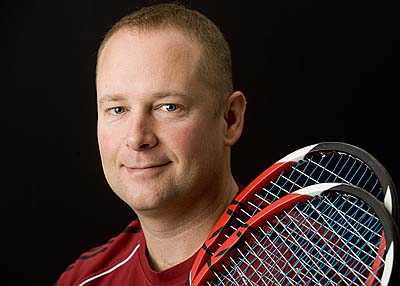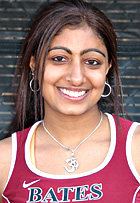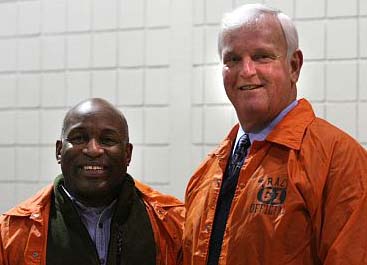Sports Notes
In May, some of the country’s best men’s tennis players will converge on the Wallach Tennis Center for the 2008 NCAA Division III Men’s Tennis Championships.
By staging the event at Bates, the NCAA has asked the College to répétez, s’il vous plaît, a phrase that serves up two ideas. The first is the event’s quick return to Bates; it was just here in 2004 and comes back in large part because of the fine job Bates did that year. The second is the event’s local flavor, provided by tournament director and tennis coach Paul Gastonguay ’89, a Lewiston native and former All-America player who returned to his alma mater 13 years ago — but not before proving his tennis tenacity among the game’s best.

Like any serious player, men’s tennis coach Paul Gastonguay ’89 never travels with just one racquet. Photograph by Phyllis Graber Jensen.
In returning to Bates in 1996, Gastonguay was coming back to a family whose local ties are racquet-string tight. His father, Jean, is a retired high school French teacher and his mother, Mercedes, is an artist who runs her own teaching studio. Both are big fans of Lewiston’s No. 1 sport, hockey, cheering on the Maineiacs of the Quebec Junior Hockey League.
Their son Paul, who spoke mostly French until kindergarten, grew up playing all kinds of sports but gravitated to tennis, captivated by his family’s passion for the sport. His father coached tennis with great success at the high school level, while his uncle Roger was the pro at Central Maine Tennis, off Lisbon Street. In high school, Paul and his brother, Marc, helped lead the Lewiston Blue Devils to a state championship.
“We were never forced to play but always found ourselves following my dad to the courts because we loved it,” he says.
Then it was on to Bates, where tennis coach George Wigton encountered this “slightly pudgy” freshman. Wigton suggested a weight program, and estimates that Gastonguay put on “probably 30 pounds of muscle, which just made him a whole different player.” Gastonguay also grew in his coach’s estimation. “He was probably the most diligent, dedicated player I ever coached,” Wigton says.
Gastonguay earned All-America honors, following in the footsteps of Bates’ first All-America player, Bud Schultz ’81. After graduation, Schultz, beginning to wind down his pro career, offered Gastonguay a job as a tennis instructor at Longwood Cricket Club in Brookline, Mass., where Schultz was tennis director. Right away, the elder Bobcat saw that Gastonguay was on the ball. “No one ever wants to pick up balls” after practice, says Schultz. “But Paul was the first person I’d ever seen who would run to pick them up.” He mentored the younger Bobcat, and Gastonguay readily credits Schultz’s “world-class coaching” for lifting his own game “to the next level.”
At the time, Schultz was an adviser to Ivan Lendl, then the No. 1–ranked men’s player in the world. Lendl called one day to ask Schultz if he could come down to Lendl’s home in Greenwich, Conn., for a few days of workouts. Schultz couldn’t, but suggested the hustling Gastonguay instead. “I sent Paul down to Lendl’s house and he never came back,” laughs Schultz.
Lendl and Gastonguay played their first match shortly after Paul rolled his beat-up Subaru up Lendl’s gated driveway. He lost, 4-6, 4-6, but won a job as Lendl’s training partner. Lendl, who once described his greatest talent as the talent to work hard, found in Gastonguay the rare workout partner who could return whatever Lendl sent his way for however long.
“I actually worried about him burning out too quickly,” recalls Lendl. “Paul was great for practicing because he would try anything and always go full out. What you need is someone who goes after every shot and tries to make every shot, no matter what the score — even if you’re beating him pretty handily.”
Says Gastonguay, “I knew that Ivan was thankful that I would work as hard as he did and never give up.”
Besides serving as a training partner, Gastonguay also worked at Lendl’s tennis center in Bedford, N.Y., in the early ’90s. In effect, he got an advanced degree in all things tennis, the teachers being Lendl, other pros who came and went, and Lendl’s primary coach, the legendary Tony Roche. “Paul learned from the best in terms of how to train for tennis,” says Schultz. Especially from working with Lendl, “Paul learned everything from fitness to technique. Everything from A to Z.”
Gastonguay was also working on his own professional game, and one hard lesson was the load of money it takes to fund a startup career. Chasing balls was one thing, but chasing money was another. “I was close,” Gastonguay says, “but it just wasn’t going to happen with my financial situation.” Encouraged by the retiring Wigton to seek the Bates coaching job, Gastonguay returned to Bates in 1996. In recent years, he’s also been raising two daughters with his wife, Leslie.
Coaching success has included various coach of the year honors; seven straight (2000–06) team appearances in the NCAA Championships; and Will Boe-Wiegaard ’06 winning Bates’ first-ever NCAA singles title in 2006. This year, he’s got some exceptional young players, including Amrit Rupasinghe ’10, Sri Lanka’s national singles champion, and Ben Stein ’09 of Pelham, N.Y., who’s advanced from a modest junior ranking to the top 25 in Division III.
“Paul has done nothing short of a miraculous job in recruiting players and also developing good athletes, like Ben, into excellent tennis players,” Schultz says.
In 2006, Gastonguay was inducted into the Auburn-Lewiston Sports Hall of Fame. Flattered to be chosen, Gastonguay was nevertheless confused, accustomed as he was to reading about his Bates elders, like former athletics director Bob Hatch or Dave Harkins ’53, being inducted.
“I wanted to make sure they realized I hadn’t retired or anything,” he said. “I’m a long way from done here.”
Sports Notes
TOURNAMENT 101 As he did when the NCAA Division III Men’s Tennis Championships came to town in 2004, head coach and tournament director Paul Gastonguay ’89 will enlist the help of Bates students, who’ll do everything from training local middle-school students to be ball boys/girls to making sure umpires’ chairs are moved as the sun shifts. And as in 2004, this year’s group will get Short Term credit under “Professor” Gastonguay, who organizes the student help into an academic independent study in tournament management. “They’ll write a daily journal to account for how things went that day and what improvements they’ll need to make,” says Gastonguay, who’ll also expect a final paper.
 WOODEN RACQUET Tennis player Mallika Raghavan ’08 (right) of Chappaqua, N.Y., was one of 14 national semifinalists for The Coach Wooden Citizenship Cup, an award recognizing outstanding role models among professional and collegiate athletes. Raghavan studied in Thailand during fall 2006 and drew on that experience last winter to help coordinate an East Coast tour by two Thai organic rice farmers (“A Fair Trade,” Summer 2007). But that’s just one of her many projects. “She is the ultimate example of an athlete who shares her talents and abilities to help others,” said Gastonguay. A four-year letterwinner and team co-captain, Raghavan “developed parts of her game that allowed her to become an aggressive, all-court player,” he added.
WOODEN RACQUET Tennis player Mallika Raghavan ’08 (right) of Chappaqua, N.Y., was one of 14 national semifinalists for The Coach Wooden Citizenship Cup, an award recognizing outstanding role models among professional and collegiate athletes. Raghavan studied in Thailand during fall 2006 and drew on that experience last winter to help coordinate an East Coast tour by two Thai organic rice farmers (“A Fair Trade,” Summer 2007). But that’s just one of her many projects. “She is the ultimate example of an athlete who shares her talents and abilities to help others,” said Gastonguay. A four-year letterwinner and team co-captain, Raghavan “developed parts of her game that allowed her to become an aggressive, all-court player,” he added.
TOP TO BOTTOM The Slovenski Indoor Track at Merrill is getting a new Mondo Super X Performance surface, similar to the outdoor track. The surface reflects light very well, so the facility will seem much brighter (also helping will be 139 new lights that use half the power but offer twice the luminescence). Men’s track coach Al Fereshetian notes that “the current track is very fast, but that’s because it’s so hard. This one will be equally as fast, but much more forgiving.”

MAYORALTY’S BACK? We noticed a different kind of Bates mayoralty at recent indoor dual meet with Colby. Serving as meet officials were (above) Lewiston mayor Laurent Gilbert and Auburn mayor John Jenkins ’74. Also in attendance was South Portland mayor Jim Soule, father of hurdler Emily Soule ’11.